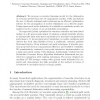Free Online Productivity Tools
i2Speak
i2Symbol
i2OCR
iTex2Img
iWeb2Print
iWeb2Shot
i2Type
iPdf2Split
iPdf2Merge
i2Bopomofo
i2Arabic
i2Style
i2Image
i2PDF
iLatex2Rtf
Sci2ools
MICCAI
2009
Springer
2009
Springer
Bayesian Maximal Paths for Coronary Artery Segmentation from 3D CT Angiograms
We propose a recursive Bayesian model for the delineation of coronary arteries from 3D CT angiograms (cardiac CTA) and discuss the use of discrete minimal path techniques as an efficient optimization scheme for the propagation of model realizations on a discrete graph. Design issues such as the definition of a suitable accumulative metric are analyzed in the context of our probabilistic formulation. Our approach jointly optimizes the vascular centerline and associated radius on a 4D space+scale graph. It employs a simple heuristic scheme to dynamically limit scale-space exploration for increased computational performance. It incorporates prior knowledge on radius variations and derives the local data likelihood from a multiscale, oriented gradient flux-based feature. From minimal cost path techniques, it inherits practical properties such as computational efficiency and workflow versatility. We quantitatively evaluated a two-point interactive implementation on a large and varied car...
| Added | 26 Jul 2010 |
| Updated | 26 Jul 2010 |
| Type | Conference |
| Year | 2009 |
| Where | MICCAI |
| Authors | David Lesage, Elsa D. Angelini, Isabelle Bloch, Gareth Funka-Lea |
Comments (0)

